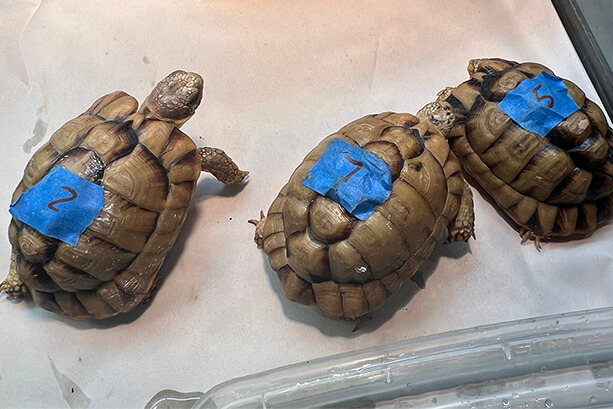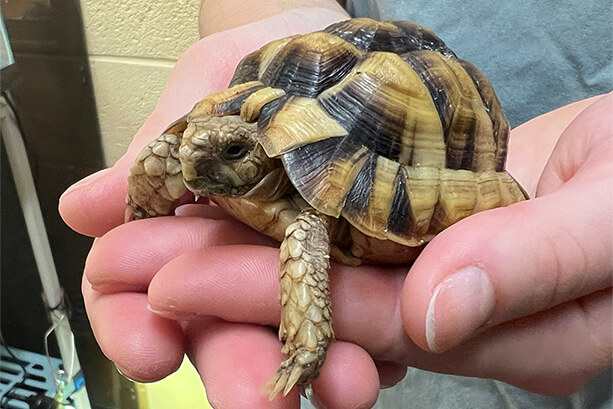The Giraffe House will be closed from Monday, July 14 through Wednesday, July 16. It will reopen for Sneak Peek viewing on Thursday, July 17.
Egyptian tortoises (Testudo kleinmanni), also known as Kleinmann’s or Leith’s tortoise, are really small and mighty cool. They’re a favorite of Danielle Regan, Area Manager for the Maryland Wilderness section of our Zoo and program coordinator for the Association of Zoos and Aquariums (AZA) Egyptian tortoise Species Survival Program (SSP).
At about 5 inches in length and maxing out at just 12.5 ounces in weight, they outperform their size with a distinctive, high domed shell and heat-reflective coloring adapted for their native desert habitats that ranges from ivory to yellow with dark edges around the carapace plates.
Despite the name, habitat loss has made them practically extinct in Egypt. Most of the wild tortoises are found in Libya. They are also coveted by the pet trade, both legal and illegal. Overall, the IUCN lists them as critically endangered.


“I’ve always really liked them, personally. And, there is an active conservation need that keeps the SSP busy,” Regan said.
“Thankfully, here in the US, you no longer see much wild animal importation & trafficking. But,” Regan points out, “There was a lot of legal pet breeding until the new rule took effect.”
That would be the 4(d) rule, so named for the section of Federal conservation law that recently increased Egyptian tortoise protections. Specifically, Section 4(d) makes it illegal to sell these animals across state lines.
Because of their work to conserve this species and the fact that no money changes hands, zoos like ours are exempt from 4(d), which is how we ended up with several Egyptian tortoises late in the Autumn of 2023.
A Winding Path
Regan was contacted by the chair of the AZA’s chelonian Taxon Advisory Group (TAG) who was alerted to available Egyptian tortoises by the Brookfield Zoo in Chicago. They, in turn, had been contacted by an agent with the Illinois Department of Natural Resources (DNR) who was in possession of seven tortoises.
The animals had been surrendered to the DNR by someone who owned them legally. We’ll never know why they were turned in but it’s reasonable to think the person intended to sell them until the 4(d) rule kicked in.
“As the SSP program coordinator I was in the best position to help find permanent homes for them at an accredited zoo. These little guys make great ambassadors for their species so, once I put the word out, it wasn’t hard to arrange good placements,” Regan said.
But time was not on her side.
“The DNR agent had these animals at his home and winter was about to hit,” Regan recalled “That’s not a good time to ship tortoises. So we needed to get them out.”


Zoos often use overnight services to ship reptiles and that’s what happened here. The agent in Illinois carefully packaged the animals in pillow cases and newspaper to keep them safe and secure, labeled the box “live animals” and “Handle with care,” and dropped them at FedEx for the flight to Baltimore.
When they didn’t arrive by 10 am the next morning, a Zoo team tracked the delinquent box to a hub at BWI airport and learned it potentially wouldn’t be delivered until the next day, which would put undue stress on the animals. So we sent a van to pick them up.
As she carefully unpacked the precious cargo, Regan was relieved to see that, despite the delay, “They were in great shape. Well cared for, healthy animals.”
Even though they looked fine, standard disease protocol requires the tortoises go into quarantine holding before the next leg of their journey. Through the SSP, Regan had homes, and even back-up homes lined up and waiting. Three of the seven tortoises were shipped to their new zoos within a week. Two shipped out the following week. And by the third week, all of the animals had been successfully relocated.
“The pet trade can get rightly vilified but, in this case, the individual who originally owned the tortoises seemed to do everything right and followed the rules,” Regan said. As a result there are seven new ambassadors helping the public learn about this amazing, critically endangered species.
 BACK TO STORIES
BACK TO STORIES
 MORE ZOOGRAM STORIES
MORE ZOOGRAM STORIES